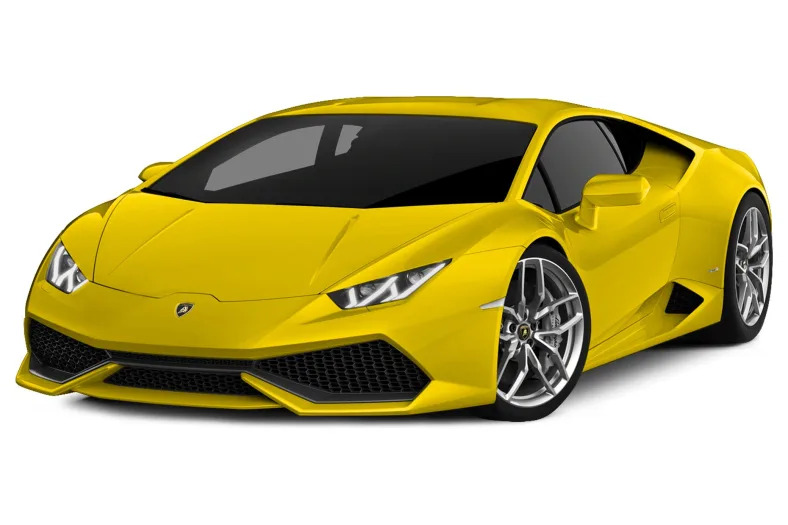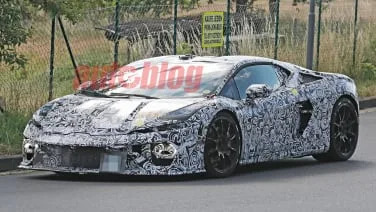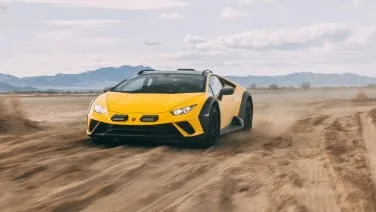2015 Lamborghini Huracan
For seven years, Lamborghini sold the Gallardo alongside the Audi R8. And despite sharing more with the Audi than most Italians would like to admit, the Gallardo was a true Lamborghini. Meanwhile the Audi R8 was every bit the stoic German. How did the Gallardo do it? Emotional distance. As cliché as it sounds, the Lamborghini felt more temperamental, although not always in a good way. That fiery disposition made it salacious at mere idle and a baying brute at the limit. The Gallardo's successor, the Huracán, incredibly is even closer to the R8 under the skin, but is galaxies apart from the Audi in terms of impression and intent. The R8 already has a reputation as an everyday supercar, faster than a speeding bullet, able to carry small groceries in a single trunk. With the Huracán, we wanted to find out if it offers the same benefits without dampening that scalding Italian attitude. That difference from old to new starts with subtlety: the Huracán's "dynamic wedge" shape doesn't boast; there isn't a single clingy component demanding your attention. The package fits together so well that you can't just look at one thing, you have to look at everything. There are details atop details, from the Y-shaped LED daytime lamps to the side glass that tucks into the body like an alien canopy. The designers worked to build in enough downforce that the Huracán wouldn't need active or moving aerodynamic devices. So whereas the Gallardo Superleggera looked good with a wing, putting such spoilage on a non-competition Huracán should incur one of those NHTSA-sized, $14,000-a-day fines. There are some hitches to just getting in and driving. There's no reflexive ease to the start and transmission procedures. We always need to remind ourselves of the steps to the dance and "Oh, that's right, pull this for Reverse." Lamborghini changed the shape of the Audi buttons lining the waterfall console, but it looks too close to the A4. The Italians also carried over that funky two-step process of pushing a button and turning a knob to control fan speed. The Huracán ditches Audi's stalks on the steering column by placing buttons on the wheel. The result is fiddly, but okay. It's a fine office, though. The cabin trim feels like eight different shades of Black Hole, and you sit so close to the ground that Lamborghini should offer a bucket-and-pulley system on the options list. The seats are firm and supportive where they need to be, and comfortable everywhere. The 12.3-inch digital instrument panel has three full-screen modes that focus on shifting at the limit, testing the terminal velocity, or using navigation. Every other important function that doesn't involve changing gears is on a row of toggles on the center stack. In truth, the only item we wish the Huracán had is a blind spot detection system. You can't see anything at the rear three-quarter, and visibility out the back window was compromised by reflections in the transparent engine bay cover on …
Full Review
For seven years, Lamborghini sold the Gallardo alongside the Audi R8. And despite sharing more with the Audi than most Italians would like to admit, the Gallardo was a true Lamborghini. Meanwhile the Audi R8 was every bit the stoic German. How did the Gallardo do it? Emotional distance. As cliché as it sounds, the Lamborghini felt more temperamental, although not always in a good way. That fiery disposition made it salacious at mere idle and a baying brute at the limit. The Gallardo's successor, the Huracán, incredibly is even closer to the R8 under the skin, but is galaxies apart from the Audi in terms of impression and intent. The R8 already has a reputation as an everyday supercar, faster than a speeding bullet, able to carry small groceries in a single trunk. With the Huracán, we wanted to find out if it offers the same benefits without dampening that scalding Italian attitude. That difference from old to new starts with subtlety: the Huracán's "dynamic wedge" shape doesn't boast; there isn't a single clingy component demanding your attention. The package fits together so well that you can't just look at one thing, you have to look at everything. There are details atop details, from the Y-shaped LED daytime lamps to the side glass that tucks into the body like an alien canopy. The designers worked to build in enough downforce that the Huracán wouldn't need active or moving aerodynamic devices. So whereas the Gallardo Superleggera looked good with a wing, putting such spoilage on a non-competition Huracán should incur one of those NHTSA-sized, $14,000-a-day fines. There are some hitches to just getting in and driving. There's no reflexive ease to the start and transmission procedures. We always need to remind ourselves of the steps to the dance and "Oh, that's right, pull this for Reverse." Lamborghini changed the shape of the Audi buttons lining the waterfall console, but it looks too close to the A4. The Italians also carried over that funky two-step process of pushing a button and turning a knob to control fan speed. The Huracán ditches Audi's stalks on the steering column by placing buttons on the wheel. The result is fiddly, but okay. It's a fine office, though. The cabin trim feels like eight different shades of Black Hole, and you sit so close to the ground that Lamborghini should offer a bucket-and-pulley system on the options list. The seats are firm and supportive where they need to be, and comfortable everywhere. The 12.3-inch digital instrument panel has three full-screen modes that focus on shifting at the limit, testing the terminal velocity, or using navigation. Every other important function that doesn't involve changing gears is on a row of toggles on the center stack. In truth, the only item we wish the Huracán had is a blind spot detection system. You can't see anything at the rear three-quarter, and visibility out the back window was compromised by reflections in the transparent engine bay cover on …
Hide Full Review
Hide Full Review
Retail Price
$237,250 - $237,250
MSRP / Window Sticker Price
| Engine | 5.2L V-10 |
| MPG | Up to 14 city / 20 highway |
| Seating | 2 Passengers |
| Transmission | 7-spd auto-shift man w/OD |
| Power | 602 @ 8250 rpm |
| Drivetrain | all wheel |
| Curb Weight | 3,135 lbs |
Smart Buy Program is powered by 





